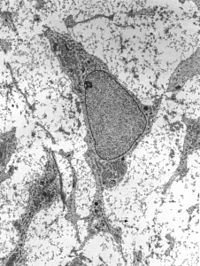
Photo from wikipedia
The transcription factor EB (TFEB) is a master regulator of lysosomal function and autophagy. Mechanistic target of rapamycin (mTOR)-mediated phosphorylation on TFEB is known to regulate TFEB subcellular localization and… Click to show full abstract
The transcription factor EB (TFEB) is a master regulator of lysosomal function and autophagy. Mechanistic target of rapamycin (mTOR)-mediated phosphorylation on TFEB is known to regulate TFEB subcellular localization and activity at the lysosomal surface. Recent studies have shown that TFEB also plays a critical role in physiological processes such as lipid metabolism, and dysfunction of TFEB has been observed in the pathogenesis of several diseases. Owing to its ability to improve disease status in murine models, TFEB has attracted attention as a therapeutic target for diseases. In this review, we will present the regulation of TFEB and its role in the pathogenesis of liver diseases, particularly non-alcoholic fatty liver disease (NAFLD).
Journal Title: Biomolecules
Year Published: 2022
Link to full text (if available)
Share on Social Media: Sign Up to like & get
recommendations!